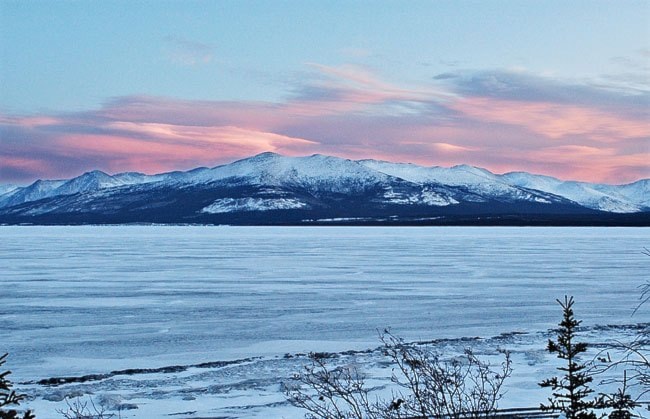DESTRUCTION BAY
A team of seven TransCanada officials spent three hours in Destruction Bay Thursday night trying to answer questions and assuage fears about the proposed Alaska Highway pipeline project.
They were matched, and doubled, by 14 residents who sat along the back of a small gymnasium in the tiny southwestern Yukon town.
But despite the intimate size and extensive time, many of the residents who attended the presentation left with the same questions they walked in with.
“There’s so many unknowns,” said Linda Lewis. “It’s hard to know what questions to ask because they don’t have the answers.”
The proposed 2,762-kilometre natural gas pipeline would cut through the Yukon, generally following the Alaska Highway from Beaver Creek to Watson Lake. It is expected to have hundreds of river and creek crossings, but the 5.4 kilometres it envisioned running along the bottom of Kluane Lake is the only planned lake crossing.
Lewis and her family still drink directly from Kluane Lake. Her home’s water system pumps it to her taps.
“There’s not many places in the world that you can still do that,” she said.
She is concerned the pipeline could affect the quality of the water.
The experts with TransCanada assured that the anticorrosive coating and layers of cement that will slather the 1.22 metre-wide pipeline under the lake will not hurt the fish. They also said that because it is natural gas, if there is a leak it will simply float up and out.
And there will be a control valve approximately every 30 kilometres of pipeline, said engineer Glen Johnston, during his presentation. These valves will automatically close if they detect any significant change in pressure, he added.
If there was a leak under the lake, it would stop, be repaired and the environment would be reclaimed, Johnston said when questioned by the residents.
He only nodded, lifted his shoulders and said “yes” to their explanation of how thick the ice on Kluane Lake can get, causing the gas to be trapped underneath it if there was a leak during winter months.
“Small leaks are hard to detect,” Johnston admitted later on, noting that they are usually only found by land patrols or people living in the area who see a change in vegetation or notice a smell.
But the experts could not say whether or not people would be able to smell the gas that will run through this pipeline.
Adding the chemical that produces that rotten-egg smell is up to the supplier, said Dan Begley, TransCanada’s lead for community and aboriginal relations. His company is “only in the business of transporting the gas,” he said.
The residents also had concerns about other sections of the proposed pipeline.
Much of the area surrounding their community has been ravaged by beetles, making it prime real estate for forest fires.
“Ruptures can cause an explosion,” said Johnston, explaining the methane that natural gas contains.
“If there’s an explosion it could set off a forest fire,” said J.P. Pinard.
“It’s not 100 per cent safe,” said Lewis. “They can’t guarantee safety. Is it not as risky because there’s not as many people in the area?”
The biggest disruption will be the construction, the experts assured.
But fish and wildlife consultants are reviewing time windows that can help mitigate disruptions to spawning and migration patterns, they said.
And if it is proven that the pipeline caused losses or significant disturbance to traplines and gravel deposits, TransCanada is liable for compensation, Johnston said.
The goal is to run the pipeline almost entirely underground, and the company hopes to start construction in 2014. It is expected to take three to five years. During that time, major construction camps would be built and later reclaimed, they said. A 240-metre-wide path would need to be cleared - but once the pipeline’s built, they would only keep about 40 metres clear, they said.
They would also need access roads, some of which would be permanent, they added.
Begley said there would also be permanent compressor stations along the pipeline, which the company wants to staff with locals.
The intention is to train and hire local people to build the pipeline, he said, mentioning that these skills will be transferable to other industries.
There has been discussion of eight “off-take points” where Yukon communities can tap into the pipeline.
But that’s up to the supplier, not the builder, said Begley.
Whether this project even cuts through the Yukon is another question TransCanada cannot answer, Begley added. There is still a proposal to only run the pipeline from Prudhoe Bay to Valdez, Alaska, where it would be liquefied and shipped to Asia.
That’s what community member Al Vance heard was going to happen.
“It all depends on the lower 48,” he said. “If they find more gas down there, what’s this going to do for anyone other than tear up the country.”
The TransCanada team offered websites, brochures, business cards and phone numbers at the end of the meeting.
“We intend to be coming through here frequently,” Begley said, mentioning another Kluane Lake area meeting in January and a full community tour next spring.
But despite claiming their openness and willingness to answer questions for the communities, Begley chastised the Yukon News and fishery biologist Chaz Ware for talking after the meeting ended.
“You’re not supposed to be doing interviews,” he said to Ware.
When asked who could answer specific questions about the effect on fish stocks in the territory, Begley repeated instructions to call the company’s media hotline in Calgary.
Contact Roxanne Stasyszyn at
roxannes@yukon-news.com
